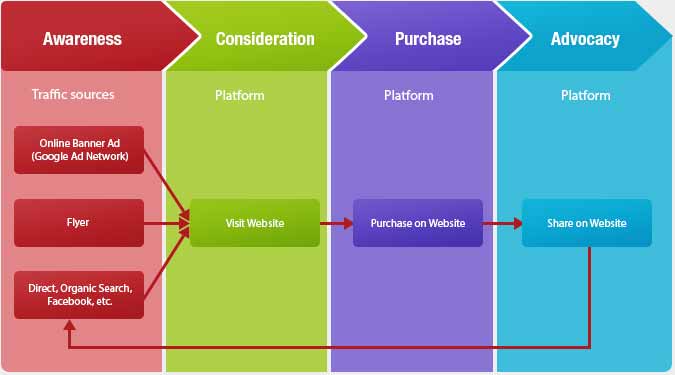Plan: Understand & Identify Your Customers' Journey towards Your Goal
Having your marketing goal in mind such as increasing sales on your website or generating leads allows you to start identifying who your target audience are and mapping out their journey (your customer’s journey) towards your goal.
A customer typically progresses through four journey stages as they interact with your brand:
- Awareness – Where customers find out that your brand/business actually exists through various marketing channels, both paid and non-paid
- Consideration – When customers visit your digital platforms, begin engaging with your content, and start to think about whether or not they want to further this “relationship”
- (Purchase) Conversion – When customers “react” to your content and display an “action” that achieves the goal you had set out for them
- Advocacy / Loyalty – When customers show their trust and become advocates for the brand/promotion, bringing in more business and value for the brand
At each stage, a customer will interact with perhaps one or multiple touch points before progressing to the next stage. Touch points referred here are marketing tactics which you may have deliberately placed to communicate with your target audience. For example:
- Awareness – Distributing flyers to reach target market
- Consideration – Serving product information to visitors via a website
- Conversion – Allowing visitors to purchase on your website via an e-commerce platform
- Advocacy – Liking and Sharing of your brand on Facebook
Each marketing tactic (paid, owned, or earned) should fulfil a role at the intended stage and is responsible for assisting your customer through the next stage. For example, when you send an email to your customer, that email is responsible for bringing awareness about your promotion/brand and also bringing your customer to your website when they click on the links in your email. An e-commerce website on the other hand can fulfil roles at two stages, Consideration and Conversion, by serving product information to your visitors and allowing online transactions for purchases.
It is recommended that you document your marketing strategy with your customer journey map for ease of reference and analysis at the later stage.
Example for Jane’s Shoes campaign:

In the above example, Jane plans to run a marketing campaign. Unlike Jane’s overall marketing efforts to sell shoes on an on-going basis, this marketing campaign has:
- A single-minded objective to clear existing stock,
- Marketing tactics such as offline & online channels to bring awareness to her campaign
- Time frame of one month - Aug 2014
- A goal to sell 400 pairs of shoes
We identified possible traffic sources and her customers’ journey to purchase on her e-commerce website – two (online banner ads & offline flyers) of which are planned with budgets invested to bring visitors to her site. The last set of traffic sources identified caters for visitors whom perhaps had been influenced after seeing her promotion ads/flyers or from their friends’ shared post via Facebook. These groups of visitors would have entered Jane’s website via either direct website address entry, search engines such as Google or clicked on their friend’s shared Facebook post.